Blog April 29, 2013: Was the Smackdown about Gold or the Apocalyptic Gold Bug Narrative?
 An already dismal situation in the resource equity sector took a turn for the worse on April 12 when 400 tonnes of paper gold was dumped onto the market under mysterious circumstances, triggering a steep decline in the price of gold that unleashed an unusual round of "goldenfreude" as the media abounded with articles mocking gold as a not so safe haven. For example Goldenfreude, a play on the German "Schadenfreude" which celebrates the misfortune of others, describes the gloating of financial advisors who shunned gold. Buffett Mocking Gold had the Oracle of Omaha pointing out gold's lack of utility and the opportunity cost it represents compared to other investments. And Gold and Canned Food as Apocalypse Hedges poked fun at the relative impracticality of gold ownership in the event that the apocalyptic future predicted by certain gold bugs did indeed materialize. At the same time people around the world lined up to buy physical bullion suddenly available at a 20% discount from the level of the past couple years, a move that reeling apocalyptic gold bugs hailed as a counter-argument to the message that "gold is dead". The truth is that the apocalyptic gold bug narrative is dead, or at least deserves to be dead, and Goldman Sachs scored a $2 billion bounty for slaying a bad story that has been poison to resource equities, and part of an insidious drive to drown the global economy in an austerity driven death spiral.
An already dismal situation in the resource equity sector took a turn for the worse on April 12 when 400 tonnes of paper gold was dumped onto the market under mysterious circumstances, triggering a steep decline in the price of gold that unleashed an unusual round of "goldenfreude" as the media abounded with articles mocking gold as a not so safe haven. For example Goldenfreude, a play on the German "Schadenfreude" which celebrates the misfortune of others, describes the gloating of financial advisors who shunned gold. Buffett Mocking Gold had the Oracle of Omaha pointing out gold's lack of utility and the opportunity cost it represents compared to other investments. And Gold and Canned Food as Apocalypse Hedges poked fun at the relative impracticality of gold ownership in the event that the apocalyptic future predicted by certain gold bugs did indeed materialize. At the same time people around the world lined up to buy physical bullion suddenly available at a 20% discount from the level of the past couple years, a move that reeling apocalyptic gold bugs hailed as a counter-argument to the message that "gold is dead". The truth is that the apocalyptic gold bug narrative is dead, or at least deserves to be dead, and Goldman Sachs scored a $2 billion bounty for slaying a bad story that has been poison to resource equities, and part of an insidious drive to drown the global economy in an austerity driven death spiral.

The Goldman Sachs smackdown of gold may prove very beneficial if it sets the stage for the purge of an unproductive gold bug narrative that has been particularly bad for gold producers, developers and explorers which have been in a downtrend since the start of 2011 when gold's phenomenal run from an interim low in October 2008 finally stalled without breaching the magical number of $2,000. Rather than the collapse of a "bubble", what we are really witnessing is an attack on the apocalyptic gold bug narrative which has dominated the investment arena but to which many gold bullion buyers, particularly those in India, are largely oblivious. If it ends up replaced by an alternative gold bug narrative that is compatible with higher real gold prices such as I have proposed during the past couple years and which I explain in a Northern Miner Mining Markets article and more recently in my April 6, 2013 Cambridge Calgary conference keynote, we could see the development of a serious bull market in gold equities that runs parallel to a global economic boom. Such a bull market could have the backing of Goldman Sachs and its Wall Street cohorts, not because a gradual uptrend in the real price of an asset class with a an absolute value of a piddling $8 trillion offers Wall Street scale profits (it doesn't), but because a real price uptrend in gold linked to a growing global economy offers substantial leveraged gains in the gold mining and development sector while allowing Wall Street to continue to play in a growing $100 trillion economy on the upside rather than the downside.

It is too soon to tell if the apocalyptic gold bug narrative will be displaced by an alternative narrative, nor may it matter, for we may be in the throes of an incipient global depression that will annihilate the junior resource sector among a lot of other institutions. But without question the gold smackdown has put the spotlight on gold, and given investors an opportunity to rethink gold's proper role in a global economy whose complexity and size has marginalized gold's historic role as a guarantor of power and facilitator of villainy. President Richard Nixon set gold free when he released it from the $35 per oz straitjacket in which FDR wrapped it during the thirties when he decreed that the US government would be the owner of all gold and would pay $35 per oz regardless how low the deflation of the depression era would drive the cost of production. America's natural gold endowment and its physical isolation from Europe's two devastating wars during the 20th century enabled it to become the dominant owner of official sector gold at the end of World War II. But that dominant position of 660 million ounces began to deteriorate after 1953 when the rest of the world's central banks took advantage of the exchangeability of gold at $35 per oz, forcing the United States to give up 373 million ounces until Nixon pulled the plug on gold's exchangeability. Since then the rest of the world's central banks have unloaded 128 million ounces, while the United States sold 30 million before stopping altogether in Q2 of 2006 when 261 million ounces reportedly remained in Fort Knox. If the conspiracy theorists are wrong and the gold still sits in Fort Knox, the United States today owns 25.7% of all official sector gold, by far the dominant owner.
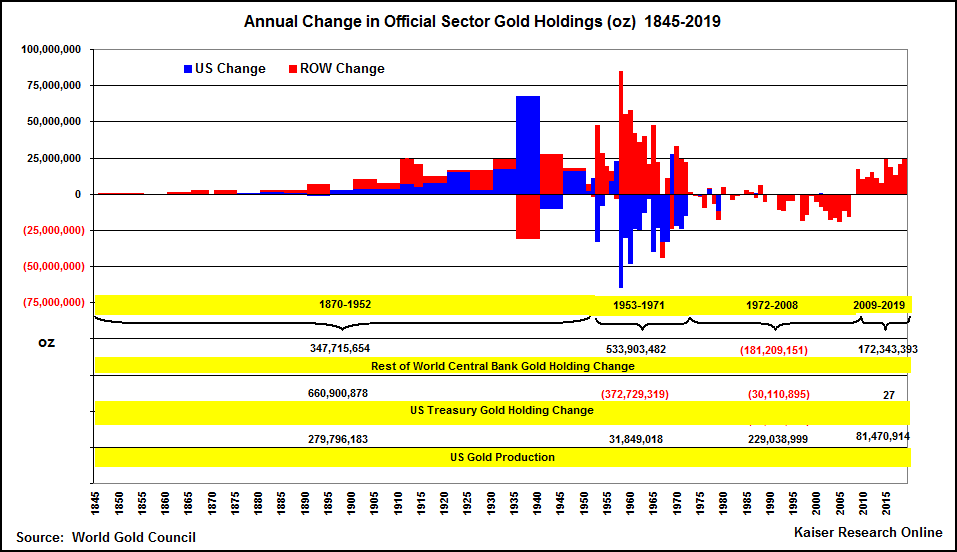
The big story since 1971 has been the shift of gold ownership from the province of central banks to the private sector which now owns 81.4% of the estimated above ground gold stock of 5.5 billion ounces worth $8 trillion at $1,470 per oz, about 11% of the $71.7 trillion global GDP in 2012. It is time for people to reflect on the expropriation of the gold narrative by right wing ideologues and join ranks with the gold buyers in India and Dubai who do not treat gold ownership as the ultimate expression of a mean-spirited, end times mentality with authoritarian overtones that underlies the split between libertarian and Tea Party proponents of the apocalyptic gold bug narrative, but instead see it as a way to be equipped to navigate what may be a hazardous future but one that offers hope of a better life.
 The next six months will be an important transition period for the resource sector in general during which the junior sector either withers away or develops an uptrend that is sustainable for many years. This situation is only partly due to the precious and base metals bear market that has besieged the sector since the start of 2011. In January 2009 I made the mistake of suggesting that we will likely never again experience a bottom-fishing window in the junior resource sector such as we did in the wake of the 2008 financial crisis when 53% of the resource sector companies covered by Kaiser Research Online were trading below a dime. Today we have reached the same level where 53% of the 1,800 KRO companies are trading below a dime while another 18% are hovering between $0.10-$0.20. This time is dangerously different because at the end of 2008 the resource equities and commodity prices were roadkill in a much broader financial meltdown, while today resource equities have been the selective focus of a downtrend that has inversely tracked the ascendancy of the apocalyptic gold bug narrative from a fringe backwater to being the ideological foundation for austerity measures that threaten to pull the global economy into the narrowly averted depression abyss that beckoned at the end of 2008.
The next six months will be an important transition period for the resource sector in general during which the junior sector either withers away or develops an uptrend that is sustainable for many years. This situation is only partly due to the precious and base metals bear market that has besieged the sector since the start of 2011. In January 2009 I made the mistake of suggesting that we will likely never again experience a bottom-fishing window in the junior resource sector such as we did in the wake of the 2008 financial crisis when 53% of the resource sector companies covered by Kaiser Research Online were trading below a dime. Today we have reached the same level where 53% of the 1,800 KRO companies are trading below a dime while another 18% are hovering between $0.10-$0.20. This time is dangerously different because at the end of 2008 the resource equities and commodity prices were roadkill in a much broader financial meltdown, while today resource equities have been the selective focus of a downtrend that has inversely tracked the ascendancy of the apocalyptic gold bug narrative from a fringe backwater to being the ideological foundation for austerity measures that threaten to pull the global economy into the narrowly averted depression abyss that beckoned at the end of 2008.
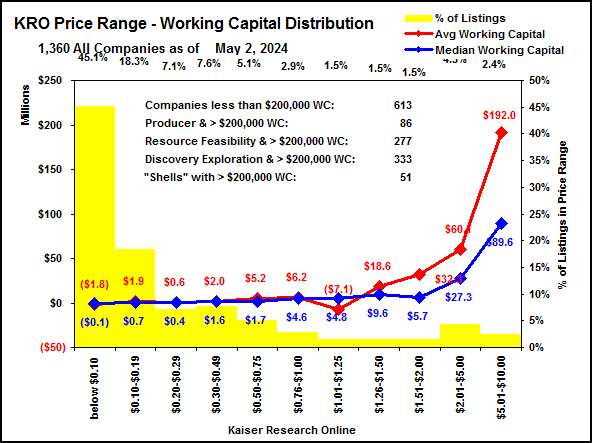
Today we have over 700 resource juniors with less than $200,000 working capital in their treasuries (39% of 1,802 still listed and trading companies featured in Kaiser Research Online), the amount needed annually to maintain a public listing while doing nothing to advance any resource projects. With each new batch of quarterly filings these working capital figures worsen, for equity financing in the resource sector has slowed to late 2003 levels (the slump in 2008-2009 does not count because unlike today, the world then was in a major liquidity crisis). Furthermore, we have structural changes underway in the financial sector that are eliminating the brokerage industry as a gateway for junior equity financings, as well as regulatory changes that are strangling the ability of resource juniors to pull capital directly into their treasuries from investors and which hamper the ability of stock exchanges to serve as a value discovery mechanism. The dependency of the TSXV on its resource sector listings is evident in the chart below which tabulates the monthly value of all TSXV private placement financings according to the focus of the listing: resources, energy, non-resource or as shell in waiting for a story. Unless there is something dramatic such as a real price spike by gold above $2,000, by 2014 there will be an awful lot of regulators joining the company side people in search of new careers.
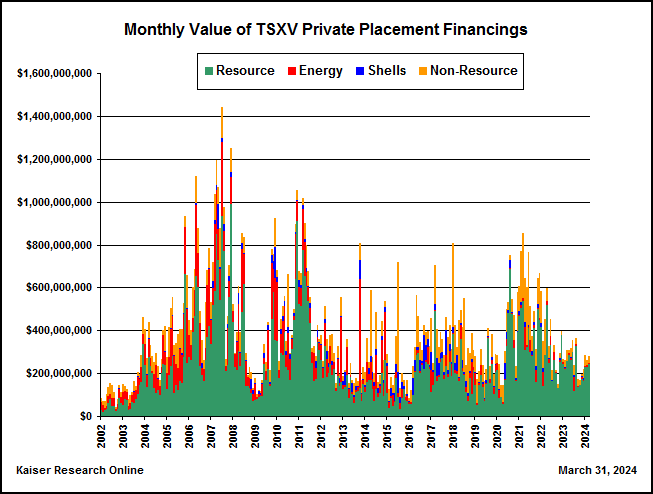
The damaging structural change is the brokerage industry's shift to an asset management model where new suitability determination rules make it almost impossible for a broker to execute a client's trade instructions, forcing investors who wish to take responsibility for their own investment decisions to open accounts at discount brokerage firms. Under the model favored by the banking establishment that controls Canada's brokerage industry, the less a broker talks to a client, the better, unless it involves coaxing more assets under the broker's management umbrella or updating the client's suitability data. Investors who do not wish to spend a lot of effort to achieve mediocre returns in their portfolio will be happy to leave that task in the hands of the brokerage industry; those seeking the excitement of speculative investments in high risk juniors will have to switch to the online trading accounts offered by the discount brokerage firms.
The regulatory changes include a ridiculously high $1 million net worth (excluding net equity in primary residential real estate) threshold for eligibility as an accredited investor who can buy private placement stock, proposals to cut out independent intermediaries who would funnel accredited investors towards a public company, the mandated fragmentation of markets through multiple order execution platforms which shutters market transparency for non-professional investors, the accommodation of frictionless computer automated trading that facilitates volatility manufacturing and capital stripping from the market, and the elimination of the uptick short selling rule which puts downside market manipulation on steroids.
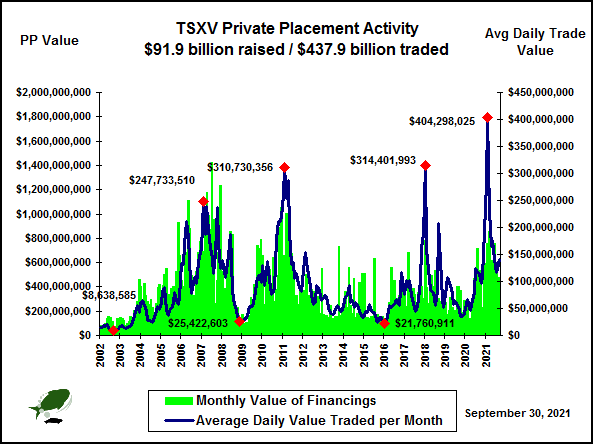
The Canadian banking establishment's support for these changes amounts to a genocidal attack on the junior public resource sector whose periodic ability to deliver triple or even four digit percentage gains poses a threat where clients disgruntled with index tracking sub-returns less the management fee leakage shift their capital away from the asset managers to the discount brokers where investors take full responsibility for managing their own risk. The downtrend in the resource sector during the past two years, helped along by the austerity measures implicitly pushed by the apocalyptic gold bug narrative, has helped the Canadian banking establishment with its goal of strangling to death the only meaningful public venture capital forum in Canada. Private placement funding for TSXV listings has shrunk to the level of late 2003 when the resource sector boom was just starting. The fact that average daily traded value remains 8 times the level that prevailed in late 2003 is misleading because much of this trading value represents back and forth algorithmic trading.

Now we are experiencing what should have happened in 2009-2010 if China had not embarked on a $600 billion infrastructure spending spree and the United States had not embarked on three rounds of quantitative easing to replace the capital looted from the banking system during the Bush administration when Wall Street swapped trillions of savings dollar deposits for securitized mortgage paper and derivatives thereof, first cranking up the net equity American households had in their primary savings vehicle, residential real estate, inducing a massive wealth effect that fueled China's soaring export machine, and then destroying $7.4 trillion that represents the biggest reverse wealth effect ever experienced by American households.

As of the end of 2012 American households had a record $9 trillion parked in bank deposits earning next to nothing thanks to a yield curve compressed by the Federal Reserve to prevent a death spiral of debt defaults at all levels. During the final quarter of 2012 American households shifted an extra $300 billion into bank deposits, the highest since Q1 of 2001 when it became clear that there would be no comeback for the dot-com bubble.

The low interest rate environment represents a an obstacle for a recovery because households, in particular retirees, are reluctant to spend on consumption because to do so would be to eat away at their principal and set the stage for trouble down the road when the government has been forced to renege on all the entitlement promises it made in earlier decades.
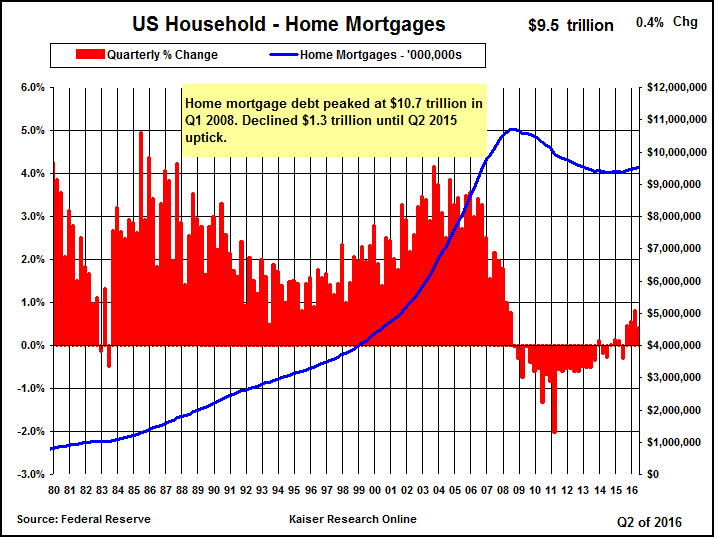
The low interest rates have also not helped to stimulate lending by the banks, which have focused on getting rid of all the underwater mortgages created by the 2008 financial crisis. Q4 of 2012 offered the first sign that the deleveraging cycle might be drawing to a close, setting the stage for a credit expansion that benefits a younger generation of workers.

Those households with exposure to stocks have done very well, but senior equity companies, having exhausted all the cost-cutting measures available after the crash to build up profit margins, now need full employment and economic growth to build the revenue side of the equation if they are not to see prices drop as a renewed global slowdown erodes profit margins. Resource equities, be they focused on precious or other metals, did enjoy a V-shaped recovery starting in Q2 of 2009 that petered out in Q2 of 2011 when the outlook for a sustained global economic recovery dimmed on three fronts: 1) the adoption of austerity as the solution to the Eurozone crisis, 2) the decision by the mid-term victorious Republicans to use a looming debt ceiling default as a tool to keep an American economic recovery from winning Obama a second term, and 3) China's curtailment of its domestic spending boom as it became apparent that neither Europe nor the United States would be pulling any serious weight any time soon. The crushing fear hanging over the resource sector is what further damage might ensue if the rest of the stock market takes a dive.

The cloud hanging over the resource sector has been the prospect of a major double-dip recession for the global economy, a prospect that caused equities to disconnect from persistently high base metal prices that only recently have begun to weaken. For two years institutional capital has been exiting the resource sector, convinced that the super-cycle that fueled extraordinary gains during the past decade would be in hiatus for at least several years, if not down for the count. What has been clear is that the destinies of copper and gold, theoretically inversely related in that copper does well during economic booms while gold does poorly, and vice versa, are in fact twinned, leaving no place for anybody with required exposure to the resource sector to hide in the event of an economic downturn. Now the gold and copper pennants are finally breaking down rather than out, fueled in part by a weaker World Economic Outlook projected by the IMF, and, perversely, in part by optimism that the American economy is finally getting some legs. A supposed additional trigger was news that China's annualized GDP growth for Q1 of 2013 came in at 7.7% rather than the consensus 7.9% expectation. Given that the difference is well within the reliability error margin for Chinese data, the focus on the "surprising" difference seems rather opportunistic.
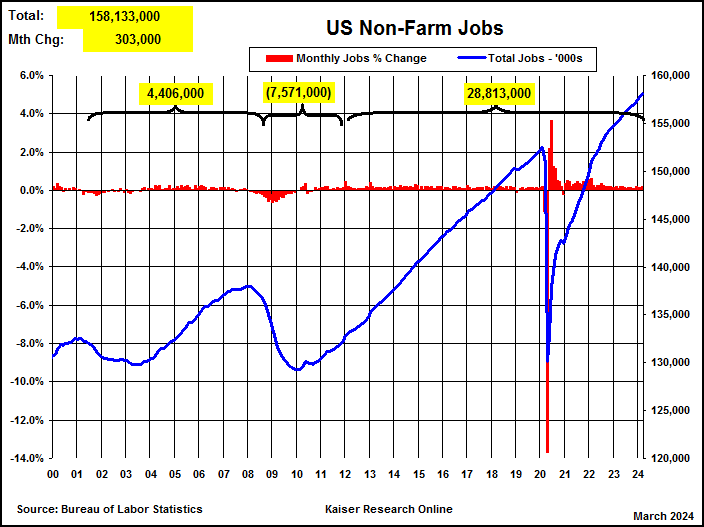
Some commentators argue that because the super-cycle is supposedly dead, so is gold, while seemingly in the same breath arguing that signs of a resurgent American economy is bad for gold because it will lead to higher interest rates and corporate equity prices as well as a stronger US dollar that zero-yielding gold cannot compete against. The US dollar has been in an uptrend since early 2011 against most currencies, but it will be a long time before it retraces the value it lost during the past decade.

What is evident is that gold appears to be trapped in conflicting narratives; no matter what outcome one can imagine, it seems to be bad for gold. The version I would like to see scuttle to the sidelines is the one that predicates a gold downtrend on an American economic uptrend. The US economy has been showing signs of itching for better growth since Obama's election victory, but job creation for March 2013 came in at only 88,000 jobs, and while the overall unemployment rate dropped, that was only because a large number of unemployed workers stopped looking for work.
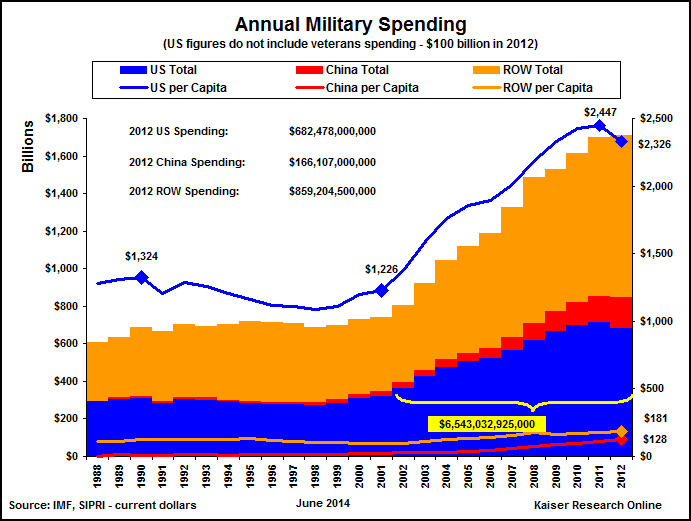
In my alternative gold narrative I see a rebounding American economy as key to higher real gold prices, because in a globalized world the American economy, while growing in absolute terms, will suffer relative decline as other emerging resource rich economies such as China with a larger population base grow at a faster pace, eclipsing the US economy in size by 2030. The prospect of a United States 15 years from now that is no longer the world's biggest economy, yet still has the sole reserve currency and an overwhelmingly superior military, strikes me as implausible. Much more likely is a scenario where multiple currencies are competing for reserve status, and the United States no longer has the capacity to unilaterally project economic and military power on a worldwide basis. Such a future is loaded with uncertainty, for which gold ownership is the simplest form of preparation, serving as that insurance policy one hopes never to have to use. Gone is the Project for a New American Century (PNAC) that the neocons turned into policy during the Bush administration when they used 911 as an excuse to nearly double military spending without funding it through higher taxes. The latest data from SIPRI indicates that US military spending has dropped to 40% of global military spending, the lowest since the end of the dot-com bubble in 2000. IMF growth projections show the US economy holding its own at 21.9% of projected global GDP between now and 2016, while China's share continues to rise despite a lower growth rate in the 7%-8% range. In its Global Trends 2030: Alternative Worlds report the National Intelligence Council takes for granted that the relative decline of American economic and military power is inevitable, and proposes a thought-provoking set of outcomes, some of them quite unpleasant. All of them make me want to have at least some of my wealth parked in gold.

An alternative scenario not contemplated by the NIC but which worries me, one that is fostered by the austerity prescription within the apocalyptic gold bug narrative, envisions the United States descending into a deep recession or even depression that destroys export dependent parasite economies such as China whose economy is not sufficiently evolved to replace America's role as the world's primary host economy. China's implosion would probably set back its eclipse of the American economy by several decades, enabling the United States to rule as the unchallenged hegemon until 2040 and beyond. In this scenario there is no short to medium term need to own gold as a hedge against turbulence in the balance of economic and geopolitical power. A global economic downturn that hurts other economies more than that of the United States would thus be bad for gold and the resource sector in general, while an economic upturn led by a resurgent American economy would be good for both gold and raw material demand, hence my contention that the destinies of precious and base metals are now twinned rather than inversely related. I suppose this makes the China Bear Jim Chanos the ultimate American patriot.

The main bright spot in the American economy has been housing starts which this year have continued the trend started in 2012 after bumping along at 50 year lows since 2008. Construction jobs have also been rising after a very long slump, joining the renaissance of manufacturing jobs that since 2010 has reversed the downtrend initiated by the Reagan-Thatcher revolution in 1980 that embraced globalization as a means to escape rising labor and emission mitigation costs. The optimism about a resurgent American economy, however, has faltered in the face of the reinstatement of full payroll taxes in the United States, and the imposition of the "sequester", a meat cleaver application of across the board government spending cuts expected to embed all sorts of disfunctionality into the American economy.

Not much talked about but looming in mid-May (apparently now postponed until August) is the end of the Treasury Secretary's ability to work around the fact that at the end of 2012 the United States hit its statutory debt ceiling. What used to be a rubber stamp approval by Congress of increases to the debt ceiling to accommodate funding of spending obligations previously made into law by Congress has been used by the Republican Party to extort concessions from the Obama administration under threat of allowing the United States to default on its debt, an outcome that would have catastrophic consequences for the United States and ultimately the global economy. While gold equities disconnected from gold at the end of 2010, other resource sector equities did not tip into a downtrend until Q2 of 2011 when it became apparent that American domestic power politics had become irrational. The compromise was to kick the can down the road through a modest increase in the debt ceiling in exchange for the "fiscal cliff", a program that would allow all the Bush era tax cuts to expire along with temporary Obama cuts such as payroll taxes while bringing on a program of cuts in all government departments, including defense.

The gambit played by the Republicans was that their party would secure control of all 3 government branches in November 2012 and be in a position to avert the fiscal cliff and a debt ceiling default. Instead, the Republicans suffered a major rebuff from American voters, but managed to retain control of the House of Representatives where a Tea Party fringe embedded through the 2010 mid-term elections now holds not just the American people and the Obama administration hostage, but even the Republican Party itself which has recognized that continued pursuit of Tea Party style policies will threaten the viability of the Republican Party as the main counter-voice to the Democrats in the 2014 mid-term elections and beyond. The failure of the Senate to pass a modest gun control bill in the wake of the Newtown massacre despite overwhelming public support sent a further worrisome signal that the "gold and guns" fringe was dictating America's future. Seemingly lost in the focus on the Boston Marathon bombing is the fact that the terrorists possessed guns that they used to kill a university police officer and terrorize a neighborhood as the police net closed upon them.
The close linkage between the apocalyptic gold bug narrative and the Tea Party flavored Republican quest for power tempts speculation that the gold smackdown has a political overtone, probably not emanating from the Democrats, but more likely from America's true economic elite which recognizes that a continuation of the Tea Party tail wagging the dog will sow the seeds of destruction for the elite. How long will it be before the dual processes of widening income disparity and weapons ubiquity spawn radicalized cells and loners who randomly take out targets within gated communities? The surge of negative articles about gold from all corners reflects less a disavowal of gold than a deep frustration with the marriage between gold and austerity policies that heighten class based stresses.
Since the 2008 financial meltdown the apocalyptic gold bug narrative has been deployed to block an economic recovery driven by government debt based fiscal stimulus of the Keynesian variety. The standard apocalyptic gold bug narrative has an ideological foundation split between free market libertarians and Tea Party style authoritarians who share a common hostility to government policy designed to redistribute wealth along egalitarian lines. Under this formulation taxation for anything but the maintenance of a military that enforces property rights is bad. In the case of the libertarian strand the underlying goal is to establish and entrench a form of feudalism where wealth, and thus power, concentrates in the hands of an elite where it is entitled to stay because the winners are such due to merit while the losers have only themselves to blame. The Tea Party strand, in contrast, has its roots in a deep-seated fear about the future which it seeks to mitigate by bringing back a "golden" past based on fundamentalist principles. Both strands see "fiat currency" as a devil's instrument which in the hand of government takes from the winners and gives to the losers, and in the process supposedly undermines the very creation of wealth so that everybody ends up a loser. The collective fear of the apocalyptic gold bugs is that fiscal stimulus not consisting of a taxpayer wealth transfer to the military-industrial complex will lead to hyper-inflation which will destroy the value of financial assets such as savings and credit securities which only have a right to repayment in their nominal monetary terms. Other assets such as land, intellectual property, raw materials, and the means of production where "rents" are not nominally fixed by contract are unaffected by hyper-inflation provided property rights remain sacrosanct and a free market economy is allowed to exist (that is, no government imposed price or rent controls).
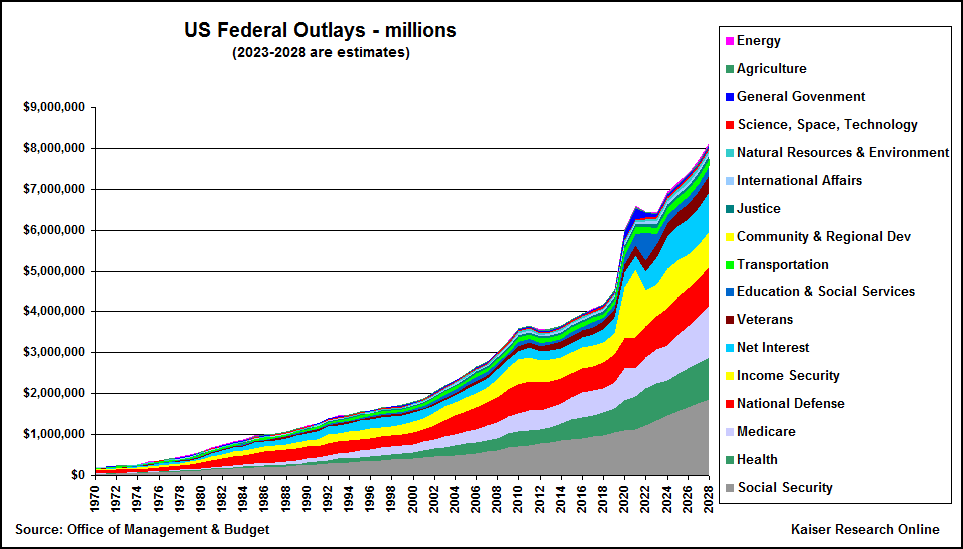
The apocalyptic gold bug obsession with America's federal debt as a source of future hyper-inflation has given gold a bad name because it pits the interests of an elite against that of the masses. The projections for federal spending through 2018 indicate that most of the spending growth is aimed at retirees through social security and healthcare. As the boomer generation retires between 2010 and 2030 the combination of an expensive healthcare system and enhanced longevity creates a staggering entitlement load which a younger generation of workers is supposed to fund through payroll and income taxes. As the revenue projections indicate, corporate taxes will provide only a fraction of future tax revenues, considerably less than the United States spends on national defense. The term "national defense" is a misnomer, because the primary purpose of the American military is to guarantee globalized trade, an expenditure that benefits the "international" interests of corporations far more than the "national" interests of Americans, whose productive jobs have migrated into lower cost jurisdictions where government regulation enables massive dumping of costs onto downstream victims.
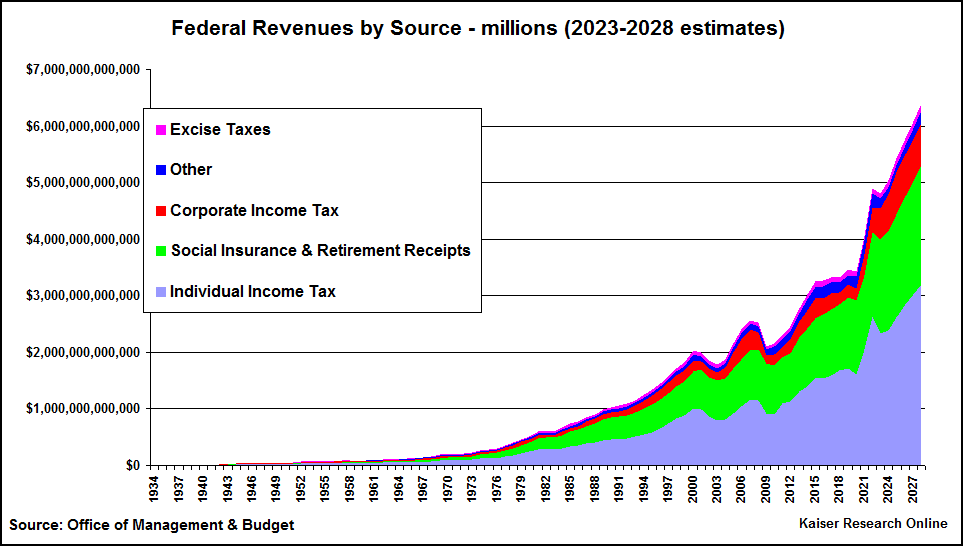
The apocalyptic gold bug demand that government be shrunk so small it can be drowned in a bathtub really amounts to solving the rising American debt problem by curtailing the lifespan of retirees, which can be done most effectively by limiting the benefits retirees can draw down as they age, or taking a meat cleaver to the gouging engaged in by the healthcare and pharmaceutical industry, an option Republican voters appear incapable of contemplating.
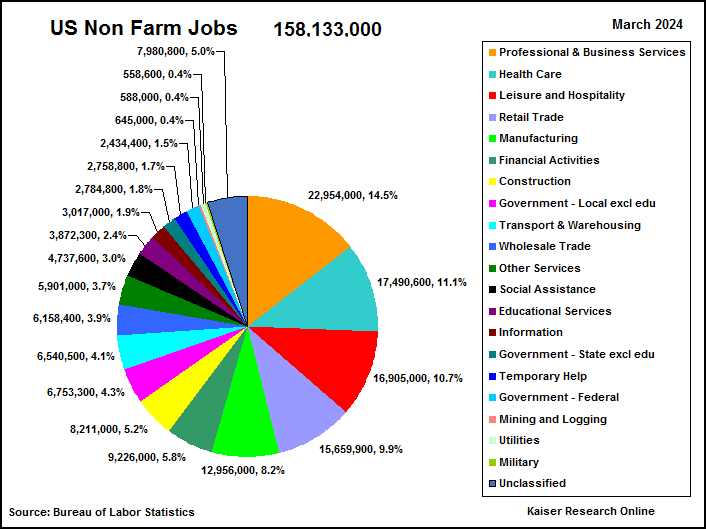
Since the start of 2010 jobs have declined at all government levels, excluding education related jobs. Healthcare jobs represent 11.4% of all non-farm jobs, standing in third place behind professional/business and retail trade jobs. Healthcare jobs underwent the third largest growth in absolute terms since 2010. All this talk about government jobs being the problem is complete nonsense; the real problem is the soaring cost of keeping retirees alive.

Medical costs are also increasing at double the rate of CPI. The retiring boomer generation's healthcare needs represent the biggest predictable long term job growth sector for our children. But who shall pay for the longevity of boomer retirees whose lifetime Medicare benefits consumption will significantly outstrip their past payroll tax contributions? Innovation in medical technology and drugs, leveraged by the digital revolution and now the genomic revolution, is a double-edged sword. There are difficult decisions on the horizon. Obvious approaches involve seeking greater efficiency and lower costs in the healthcare industry and raising Medicare payroll taxes, possibly by boosting the income cap that limits the application of payroll taxes.

The most unpopular choice will involve raising Medicare premiums and deductibles for retirees, in effect rationing healthcare on the basis of the retiree's personal wealth. Those who have will live longer than the have nots, something already evident in the statistics which indicate higher longevity for retirees with higher lifetime incomes. Because there is an income cap on which Medicare taxes are paid, we have the ironic situation that people who enjoyed higher incomes during their working years live longer than lower income workers, and thus consume a much greater proportion of Medicare benefits while also having accumulated surplus wealth available to enjoy their retirement years. Assisted suicide for the elderly who no longer have the means to fund their ongoing healthcare needs is going to become a hot button issue with inevitable allusions to the disturbingly prescient 1973 film Soylent Green. The unfairness of this situation which constitutes an income based "death panel" for retirees will not go unnoticed by voters, which is why the big battle looming in the United States will be between the defense and retiree benefit budgets.

The loser has to be defense spending, thanks in part to the celebrated shale oil and gas revolution which is expected to achieve oil self-sufficiency for the United States by 2020. The United States has been a net importer of oil since the early seventies, though its oil consumption has been flat since 1980 while global consumption has grown 50%, with China emerging as the second biggest oil consumer. During the next few years China's oil deficit will exceed that of the United States, which may even end up with an exportable oil surplus if the push for higher fuel efficiency and consumer preference for hybrid style cars stay on track. Given that half of the $6.5 trillion spent on defense during the past decade was sucked up by the invasion of Iraq on fraudulent premises with a delusional exit strategy, a move that only made strategic sense in the context of oil security of supply, questions will rise as to why the United States needs to fund 40% of global military spending at an astonishing cost of $2,326 per capita, compared to $128 per capita for China, which will be the prime beneficiary of oil flowing from unstable parts of the world. China's oil import dependency and the fact that its car ownership intensity is a tiny fraction of that of the United States, a similar sized country, underpins China's interest in locking up the oil potential in the South China Sea for its own account. The American pivot to Asia, ostensibly to shore up the defenses of its non-Chinese allies, is in fact a containment strategy designed to preserve China's oil import dependency, and force China to play a greater role in keeping the "peace" in oil regions such as the Middle East. American taxpayers will not look too kindly on a tradeoff which cuts off Medicare benefits in order to pay for a military that supports the international flow of oil for the benefit of emerging superpower competitors such as China.

A growing unwillingness by American taxpayers to fund the projection of absolute military power in a world where America's economy is undergoing relative decline is a key part of an alternative gold bug narrative which contemplates the geopolitical uncertainty that will accompany America's retreat to greater domestic self-sufficiency. Although the apocalyptic gold bug narrative has an America bashing aspect to it, it is more of a moralizing nature which warns of the consequences of an America that loses its status as the world's sole superpower. Non-Americans who buy and hold gold do not share this enthusiasm for the continuation of America's ability to unilaterally project its power, though they do appreciate that an American hegemon is likely the lesser of possible evils. They will be far more receptive to an alternative gold bug narrative than Americans who embrace the apocalyptic gold bug narrative as a form of denial about what the future has in store. The apocalyptic gold bug narrative is restrictive because its proponents do not want to contemplate the reasons why a higher real gold price is inevitable. Most apocalyptic gold bugs have a simplistic outcome in mind where by paying fiat dollars for gold they will eventually be in a position to swap that gold back for a much bigger fistful of fiat dollars that they hope to spend on things that are useful or pleasurable. The intellectual bankruptcy of this narrative is that the bigger fistful of fiat dollars will buy the same quantity of good and dollars as the handful of dollars paid for the gold did before the currency debasement took effect. Even worse than gold ownership just being a wash, the Internal Revenue Service will demand a 28% collectible capital gain tax, and states such as California will tack on a state tax, reducing that fistful of dollars by as much as 38%. Buying gold as an inflation hedge makes no sense unless you plan not to pay taxes or expect that the taxation regime will have collapsed or fiat currencies have ceased to exist. The latter world would have reverted to a barter system where gold serves as one of many tradable assets. In the transition to such a world junior resource sector equities would disappear because there would not be a money system to establish relative value.
The uselessness of the apocalyptic gold bug narrative for resource equities is obvious to investors who do not treat gold as a form of ideological jewelry. Such investors are looking for a reason to expect a higher real price for gold, one that expands the profitability of mining an ounce in the ground. But the prospect of a slowing global economy and a resurgent American economy with respective negative implications for base and precious metals prices in the near term constitutes a double whammy for the resource sector. During the past five years mining sector costs have increased considerably more than general inflation which has been muted at less than 2.5% in the United States. According to Nick Holland of Goldfields in a July 2012 presentation he gave to the Melbourne Club, mining sector capital and operating costs have escalated on average by 10% annually. A gold deposit that was marginal at $900 in 2008 would thus have seen its all-in cost increase 60%, making it marginal at $1,440 gold, a level through which gold blew on April 15.

To some degree the gold mining industry has itself to blame, for it allowed histrionic gold bug predictions of $3,000 plus gold to serve as justification for acquiring and developing deposits that would be fabulously profitable at $3,000 gold, provided costs did not track the rise in the gold price. The problem, however, is that the dominant gold bug narrative promises no such thing for gold producers, for gold is merely an emotional tool for an ideological agenda that exploits the economically inconsequential truth that if you excessively expand the money supply without a corresponding growth in wealth creation, the price of gold will rise accordingly. In simple terms, gold might very well soar to $10,000 per oz in the event that a debt default causes the US dollar to collapse against all currencies, or "quantitative easing" is stepped up by an order of magnitude, but the gold mining industry has gained nothing if the all-in cost of production has arithmetically marched up to $9,990 per oz.
The gold mining industry has also not been helped by the insistence of smart people like Ned Goodman and Eric Sprott heavily involved in resource sector financing that "gold is money", which is not true because money is an information system that allows easily transferable IOU's to exist over space and time, thereby facilitating the unlimited economic exchange of goods and services. Such an information system should have a minimal cost, which disqualifies gold as money. What IOU information systems can suffer from is confidence in their integrity, which is why gold has in the past served as a guarantor of money, what is referred to as a gold standard. Gold is not necessary for a thriving economy to evolve; for a fascinating discussion of the various money information systems societies have invented, I recommend Debt: The First 5,000 Years by anthropologist David Graeber.
Gold is unsuitable as money because it has a high energy cost to bring into concentrated above ground existence. The World Gold Council estimates that about 171,000 tonnes of gold exist as above ground gold, which translates into 5.5 billion ounces. What makes gold special is its rarity, its malleability into any form, its inertness, and a lustre which has an aesthetic appeal that seems to be hard-coded into human DNA. A high density bestows upon it a high degree of portability, and, unlike diamonds whose value resides in a fragile crystal structure, gold is divisible such that the sum of the parts is always worth the value of the whole. But its portability is substantially less than money, which need not exist in physical form because it is just information about relationships between individuals and the assets that constitute the real world. Money is an abstract social construct; gold is a tangible real asset.
During the past week we have heard a number of prominent people pontificate that gold has no intrinsic value, which is not true because the intrinsic value is the energy input required to bring a meaningful amount of additional gold into existence. This the gold miners understand very well, because moving, breaking and grinding up gold bearing rock is a major energy cost, followed by the energy costs required to provide the reagents used to extract the gold, and in some cases to first heat the ore when it is refractory. The miners also understand that these days properly disposing of tailings and treating the emissions is a new cost not borne by historical gold production. Nearly all aspects of metal production costs except "rent" demanded by owners such as nations can be expressed in terms of energy units. If for whatever reason the world needed to double the above ground gold stock, the energy input would be substantially higher than what it cost to amass the first 5.5 million ounces, in part because humans always first harvest the low-hanging fruit.

What counts as low hanging fruit depends on the price of gold and deposit characteristics such as grade, location and metallurgy. Exploration, geopolitical change and technology innovation can alter the latter, but the most effective way to turn high hanging fruit into low hanging fruit is for substantially higher real gold prices to materialize, as happened during the seventies when gold's artificial peg to $35 per oz was cancelled, enabling gold to soar to an $850 peak in 1980 before "crashing" back to the $400 level around which it oscillated 15% until breaking down in 1998 on its way to a multi-decade low in 2001. Lost in the current discussion about gold's recent "crash" is the fact that when gold settled down at $400 in 1980, nominally 900% above where it started, the price was still 419% above where it started in 1971 in real price terms whereby the US CPI is applied to the $35 per oz price. During the seventies what counted as low hanging fruit in the gold sector was defined by the $35 gold price. That changed when Nixon freed gold from its monetary prison.
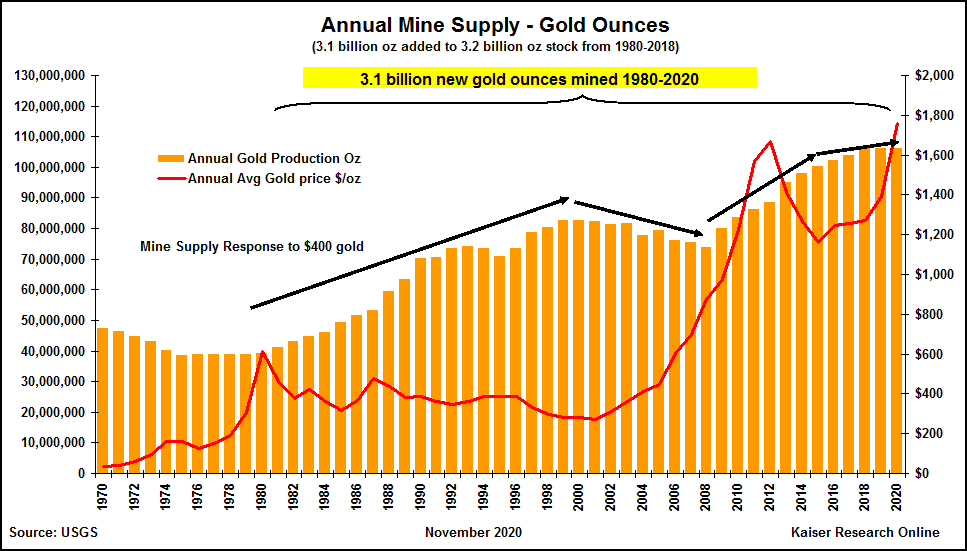
The mining industry's supply response to a dramatically expanded bounty of low hanging fruit created by the higher real gold price did not kick in until 1980 and beyond. In the three decades since gold's adjustment to a free market pricing mechanism and stabilization at $400 the mining industry has inflated the above ground gold stock by 2.3 billion ounces or 40%. In contrast, the mining industry produced 2.7 billion ounces from the start of the California Gold Rush in 1948 through 1979, implying that it took several thousand years to produce the first 500 million ounces. In the absence of higher real prices, the next frontier capable of inflating substantially a new supply of low hanging fruit would have to be an energy breakthrough that drastically cuts the real cost of gold extraction.
Given that gold, unlike silver, does not generally get fabricated into useful forms that prevent the gold stock from serving as a theoretically constant "for sale" overhang, it is no surprise that gold was the worst performing asset class from 1980-2002. The situation was compounded by official sector selling which gradually reduced the official sector's share of the above ground gold stock from a peak of 49% in 1959 to a low of 29,963 tonnes in 2007 which represented 19% of the gold stock. Since 2007 the absolute holdings of official sector gold have risen 675 tonnes from 30,275 tonnes to 30,950 tonnes as of the end of 2012, though at 18.6% of the above ground gold stock official sector gold holdings are the lowest they have been since 1910. The price "bubble" represented by gold's run to an intra-day peak of $1,920 has merely been a delayed catchup after several decades of unprecedented new mine supply.
A big deal has been made about the recent reversal of the trend of net central bank gold liquidation, but the amount tallied so far is trivial relative to the amount central banks could soak up if accumulation of gold as a form of foreign exchange reserves were to escalate. There are good reasons to expect this to happen during the next five years, and they form part of an alternative gold bug narrative that does offer a promise of higher real prices to the gold mining industry. The smackdown of gold below $1,400 is very different than 1980 because today these levels leave very little low hanging fruit in the ground for the mining industry to profitably harvest. The projection of annual gold mine supply climbing to 100 million ounces over the next three years simply will not happen because the mining industry has already embarked on a campaign to rationalize existing operations and shelve the development of large scale projects that require a real gold price well above $1,600 to be profitable. Gold at smackdown or lower levels requires demand for physical gold to diminish going forward, accompanied by a rise in the desire to convert gold holdings into another asset class, something that the lineups of people buying gold because it has gone "down" rather than "up" suggests is not going to happen.
It is true that because gold does not have a utility for which there are no cheaper substitutes in terms of energy consumed per unit of functionality, its value could collapse to zero. The same could happen to anything not essential to human survival. Diamonds are rare, but if society decides to view them as nothing more than octahedrally crystallized bits of carbon, nobody will transfer any "energy" to purchase a diamond. But it will be some time before gold becomes the "barbarous relic" John Maynard Keynes dismissed it as, though to be fair he said this correctly in the context of gold serving as a guarantor of money, let alone as a substitute for money. The gold standard became obsolete because the energy value of the global economy outgrew the world's ability to mobilize gold into above ground form at a fixed energy cost. There is an extraordinary absolute amount of gold distributed within the earth's crust and dissolved in seawater, but the energy cost of extracting this gold grows exponentially with the quantity of gold desired.
It is precisely because of the rising cost of incremental new gold supply and the existence of multiple money systems in the form of national currencies that the existing gold stock holds its value, and even has the potential to achieve a higher real value understood as a surplus between the price of gold and its marginal production cost. This is the profit margin on which the resource sector lives, and it is not what is promised by the apocalyptic gold bug narrative which is the real target of the smackdown. The gold mining sector needs a narrative that promises a higher real price, and that is not what the apocalyptic gold bug narrative promises. Although the gold smackdown has tipped the gold equity price downtrend near vertical, creating capitulation market conditions in the resource equity sector, it strikes me that the target of the smackdown is less gold than it is the domination of the narrative by the apocalyptic gold bugs. This could be a turning point for the gold equity sector, provided that a productive gold narrative emerges to replace the purged one.

Higher long term real gold prices are not going to materialize with the help of the various gold ETF products because these are largely used for short to medium term trading strategies and for portfolio balancing purposes. The most popular ETF, the SPDR Gold Trust which trades on the NYSE as GLD, peaked at 43.5 million ounces on December 7, 2012. Since then its gold holdings have declined 8.7 million ounces (20%) to 34.8 million ounces as of April 26, 2013, losing only 2.3 million ounces since the smackdown began on April 12, 2013. The bear attack on gold was well underway when Goldman Sachs nudged its Genius Contrarian to offer an official thumbs down, which Societe Generale had already signaled a couple weeks earlier based on optimism about the American recovery (Gold Bubble Seen Turning to Bear Market by SocGen on Recovery). The violence of the smackdown led Goldman Sachs to close out its bearish recommendation on April 23 (Goldman Cuts Commodity Outlook as It Exits Bet on Gold Drop), effectively offering a new trading range of $1,390-$1,530 for the rest of the year. Implicit in Goldman's weak outlook for gold is an even more bearish stance on commodities in general, suggesting that Goldman Sachs also believes that the destinies of copper and gold are now twinned, and that the bias is to the downside for the global economy.
 With $9 trillion parked in bank deposits earning near zero interest, which has the dubious benefit of minimizing savers' tax bills and the promise that no American bank will be allowed to fail or have a Cyprus haircut inflicted on depositors, making it stay exactly as it is minus the negative real return implied by the current CPI, it is unlikely that we will see a market moving inflow into the GLD ETF now that its volatility has been demonstrated. Much fuss has been made about the little people around the world lining up to buy physical gold, but this demand source is too small to drive up the price. Furthermore when there is no more bullion on the shelf, the store simply closes shop. The truth is, whatever physical gold was lying around in public hands has been soaked up during the past decade by those "cash for gold" shops which paid a discounted price for crappy and stolen gold jewelry that got melted down and forward sold as bullion. The next really big wave of bullion buying will come from the central bank sector, not because of any near term concern about the collapse of the US dollar against all these other wonderful currencies, or fear of hyper-inflation, though that might have been a concern if some of the more clownish Republican presidential candidates had managed to achieve the presidency, but rather because central banks have the luxury of long term planning. For example, Germany's request that the United States transfer Germany's gold holdings back to Germany over a six year period reflects not short term anxiety, but recognition that in the long run it would be unwise to have one's gold stashed in the vaults of a nation adapting to a new reality where it is no longer the sole super-power.
With $9 trillion parked in bank deposits earning near zero interest, which has the dubious benefit of minimizing savers' tax bills and the promise that no American bank will be allowed to fail or have a Cyprus haircut inflicted on depositors, making it stay exactly as it is minus the negative real return implied by the current CPI, it is unlikely that we will see a market moving inflow into the GLD ETF now that its volatility has been demonstrated. Much fuss has been made about the little people around the world lining up to buy physical gold, but this demand source is too small to drive up the price. Furthermore when there is no more bullion on the shelf, the store simply closes shop. The truth is, whatever physical gold was lying around in public hands has been soaked up during the past decade by those "cash for gold" shops which paid a discounted price for crappy and stolen gold jewelry that got melted down and forward sold as bullion. The next really big wave of bullion buying will come from the central bank sector, not because of any near term concern about the collapse of the US dollar against all these other wonderful currencies, or fear of hyper-inflation, though that might have been a concern if some of the more clownish Republican presidential candidates had managed to achieve the presidency, but rather because central banks have the luxury of long term planning. For example, Germany's request that the United States transfer Germany's gold holdings back to Germany over a six year period reflects not short term anxiety, but recognition that in the long run it would be unwise to have one's gold stashed in the vaults of a nation adapting to a new reality where it is no longer the sole super-power.
The pundits who mock gold as having little intrinsic value are not considering the possibility that official sector buying may escalate. Instead they focus on the possibility of the Cyprus central bank's trivial amount of 14 tonnes being dumped onto the market, followed by the not so trivial amounts of 2,452, 383, and 282 tonnes held respectively by Italy, Portugal and Spain. A report produced by the OMFIF on behalf of the World Gold Council, Gold, the renminbi and the multi-currency reserve system, makes a strong case for increased central bank gold buying over the next decade. The possibility of rising official sector gold buying, more than enough to offset any forced Eurozone liquidation, is the best hope we have for a higher real gold price in the near term that benefits the gold mining sector.

The possibility that the next wave of buying will be driven by central banks has received its share of mainstream mockery, such as Bloomberg's description of the smackdown as a Gold Rout for Central Banks, which supposedly cost them $560 billion from the $1,921 peak in September 2011. Implicit in the article is the trading culture for whom Bloomberg is in the business of manufacturing volatility, such as it managed to achieve for its $25,000 terminal customers when it retransmitted a Twitter hoax that temporarily wiped out $156 billion in equity market cap as algo traders picked up on the implications of a terror attack on the White House (Twitter Speaks, Markets Listen and Fears Rise). Central banks are not in the business of demonstrating their cleverness by trading their gold; they either liquidate or accumulate it.

As mentioned earlier, central banks have boosted their net gold holdings only 675 tonnes since 2007, and that includes the 454 tonnes China "added" to its holdings in Q2 of 2009, a 76% increase from when it last reported a change in Q3 of 2002. What the net numbers alone do not reveal is the breakdown as to which central "banks" are selling and which are buying, which the change since 2007 chart above makes clear. The selling of 1,861 tonnes is dominated by the IMF and the ECB, a couple of "rogue" nations Libya and Venezuela whose disposition may not be real, and mature European countries which may still rank among the top 10 economies, but which lack the capacity to project military and economic power and certainly will not gain in that capacity by 2030. On the other hand, the 2,536 tonnes bought was generally by countries which by virtue of their population and/or resource bases are medium to long term challengers to displace the United States from its status as sole super-power in a globalized economy: Russia, China, India and Brazil among the BRIC nations, as well as Turkey and Mexico. These central bank gold buyers are buying for the long haul in preparation for a future when the US dollar becomes unstable as the world's single reserve currency with no obvious replacement. Given the dubious future of the Eurozone as a single currency economic powerhouse, the unlikelihood that a demographically challenged Japan can revitalize itself, and the simple fact that in a globalized growing economy the United States will undergo relative decline in terms of its capacity to unilaterally project economic and military power, it makes no sense for emerging nations to have their foreign reserves parked exclusively in dollars, euros and yen. Gold may not be money, but in times of transitional trouble it works very well as collateral.

As it now stands the GLD ETF at 34.8 million ounces is in sixth place in terms of official sector holdings, just ahead of China's 33.9 million ounces (multiply tonnes by 32,151 to get ounces). What may not be obvious to the general market is that China's central bank gold holdings have likely doubled since it last provided an update. Between 2002 when China reported holding 600 tonnes and 2009 when it reported holding 1054, a gain of 454 tonnes, China produced 1,431 tonnes of gold or 46 million ounces starting with production of 4,650,000 ounces in 2003. Since the end of 2008 China has produced 1,384 tonnes or 44.5 million ounces and completed 2012 with record production of 11.9 million ounces or 370 tonnes. If reports are true that all gold production must be sold to the Chinese central bank, as was the case with the United States during the thirties when gold was repriced at $35 per oz, then it is conceivable that if China were to update its central bank gold holdings today, it would add 44.5 million ounces, boosting its total holding to 78.4 million ounces or 2,438 tonnes, putting it in neck and neck with Italy and France for fourth place. If Chinese gold production plateaued at 370 tonnes and held steady indefinitely while China's central bank bought every ounce produced, its holdings would surpass in 15 years the 8,133 tonnes currently held by the United States. This assumes that none of the net gold imports to mainland China since 2008 have been bought by the central bank. Why doesn't China regularly update its official sector holdings as does Russia and most of the other nations? China's leadership can be called all manner of things, but "stupid" is not one of them.

China is sitting on $1.37 trillion worth of US dollar denominated foreign reserves which does not give it any serious clout against the United States, largely because as an export dependent nation with a serious oil import vulnerability any move to "punish" the United States through liquidation of treasury bills and other government agency securities would cause the renminbi to soar against the US dollar, and probably every other currency too. China's multi-decade long comparative economic advantage based on the migration of cheap labor to the coast, the absence of a western style safety net both in the workplace and retirement, and a willingness to absorb environmental costs unacceptable in advanced nations is starting to erode. Labor unrest about low wages and lousy health and safety standards coupled with civil unrest over pollution while an emerging economic elite flexes its muscle outside the rule of law is turning China into a domestic pressure cooker that can ill-afford an exchange rate driven boost in the cost of its export goods. China is the last nation that can afford a collapse of globalized trade, be it through military conflict in southeast Asia arising from disputed territorial waters or an out-of-control North Korea, or a trade war created by China's voluntary beggaring of the US dollar. China's long term strategy has to be to gradually convert its US dollar reserves into the ownership of gold and hard assets in the rest of the world. With that in mind one cannot but help imagine the delight Beijing must have experienced over the smackdown Goldman Sachs inflicted on the apocalyptic gold bug narrative. While it is true that American households and businesses own only $3.4 trillion in federal debt, while government agencies own $4.8 trillion and foreigners own $9 trillion, the foreign debt is all denominated in US dollars. While it was possible to bring sovereign Latin American borrowers to their knees during the seventies, that was only because the money they borrowed was repayable in US dollar; they could not print their own currency to repay the debt. The foreign holdings of US debt is more a trap for the foreigners than the United States.
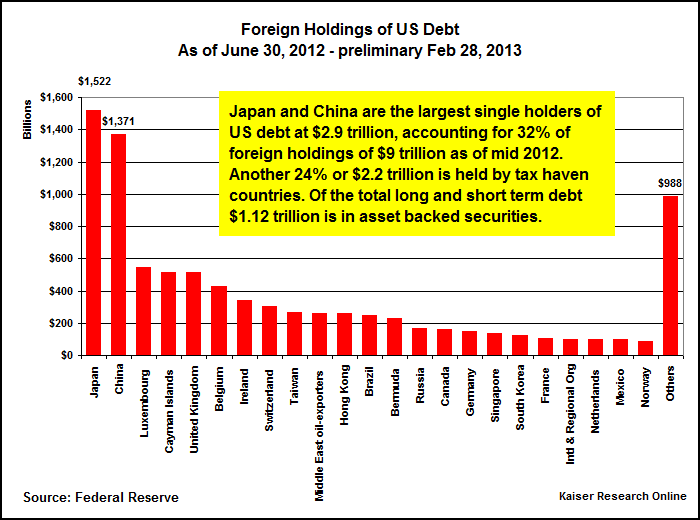
My alternative gold bug narrative looks at the value of the above ground gold stock as a percentage of nominal global GDP, the best measure of the wealth of the global economy. When looked at in these terms, which account for currency exchange rates and new mine supply, the gold "price" does not have the exponential "bubble" chart pattern we see in a plot of the US dollar gold price alone. We see a spike to 25.7% in 1980 during a period of extreme geopolitical stress and inflation worries when it appeared that the United States was losing it as the dominant super-power balancing the Soviet Union in the Cold War. When gold retreated to $400 the value of the gold stock relative to global GDP was still a lofty 18.5%, but over the next two decades as the United States won the Cold War and emerged as the undisputed hegemon, the value of the gold stock declined to 3.9% in 2001 ahead of the 911 terror attack.

The two most important developments of the first decade of the 21st century was the emergence of a dispersed non-state enemy in the form of radical Islam, and the emergence of China as the world's second biggest economy. The creation of the real estate bubble was in part a response to the uncertainty created by 911 in the wake of the collapse of the dot-com bubble. It fueled the rise of China and provided the tinder for the 2008 conflagration that nearly took down the global financial system. At its peak in 2011 the gold stock value was 14.4% of GDP, just over half the peak achieved in 1980. If we treat gold's value as a function of global uncertainty since it was unyoked from the $35 peg in 1971, we can construct a simple model that allows us to predict the gold price based on estimates about structural anxiety, global GDP growth, and new mine supply. New mine supply can be projected based on development and production costs as well as the multi-year timeline to bring committed new production on stream. The IMF takes care of global GDP growth projections, which ultimately are at the mercy of political decisions made by economic heavyweights such as the United States, China, Japan and Germany. What we cannot predict with accuracy is the degree of anxiety that will permeate the world during the next five years. If we assume a 10% level of anxiety, and convert the projected gold stock and GDP back into a gold price, and provide it with a 10% annual volatility around the average price, we could predict a trading range of $1,237-$1,512 for 2014, rising to $1,332-$1,662 by 2016.
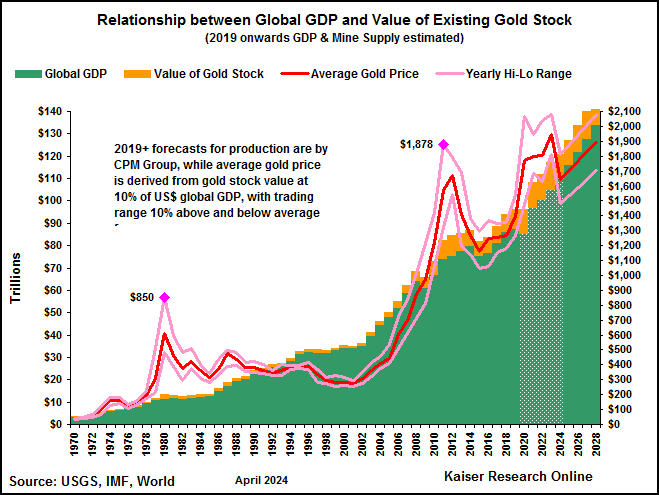
On the other hand, if we expand the anxiety levels to the 25.7% peak in 1980 and 3.9% nadir in 2001, we see comparable upside and downside prices of $3,431 and $477 for 2013. That uncertainty might diminish sufficiently to allow gold to sink back to $477 per oz, where effectively there would be no new mine supply and also no need for any, does not seem even remotely imaginable. On the other hand, if Kim Jong-Un launches a nuclear attack or some radical variation thereof in a desperate effort to keep the Kim dynasty from being squeezed out by a North Korean military eager to "get rich" like the Communist Chinese and Soviet brethren did two decades ago, and China bobbles its reaction to the American response, the resulting geopolitical stresses could easily shoot gold past $2,000 in real price terms, with an unsustainable assault on $3,000 conceivable.

A similar model can be applied to the above ground stock of silver, the poor man's gold, though the 14.1% peak achieved in 1980 when silver hit $50 per oz was more the result of a market manipulation than a response to stresses. But if we assume 3% of GDP as a reasonable anxiety measure as expressed through silver, we can see silver stable in the $30-$50 range during the next four years. That sort of price performance is not going to make Eric Sprott very happy, but long term stability of such a price range for silver has big implications for silver producers and developers whose valuations are skewed towards a return below $20 for the silver price.
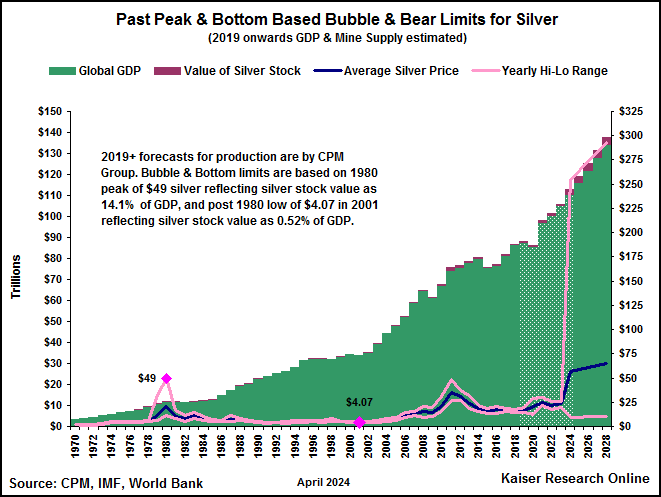
My alternative gold bug narrative with its promise of higher real prices as the global economy grows, the United States flourishes but loses relative ground and is forced to adopt a more collaborative stance on the geopolitical stage, and the new big kids on the block like China stumble about like youngsters who have finally reached the legal drinking age, is bullish for the resource sector, not just precious metals, but all raw materials. With this type of gold bug narrative it is also conceivable that American investors could develop a keen interest in funding the discovery and development of new gold mines on American soil. Between 1848-1952 the United States produced 280 million gold ounces, followed by a slump of 32 million ounces between 1953-71 when gold was stuck at $35 and the low hanging fruit had been harvested. But since 1972 the United States has produced 259 million ounces, most of it from Nevada where at least another identified 80 million ounces remain to be mined. The US government did not buy a single one of those 259 million ounces produced since 1972; it was all bought by the private sector, and maybe a few foreign central banks. What if the United States down the road adopted a new policy whereby it would buy every new ounce of gold at the prevailing global market price, just as China does today, in an effort to rebuild its gold reserves in preparation for a new reality where the US dollar may no longer be the single reserve currency, a new reality where in fact there may be equal or stronger super-powers?

But after producing 571 million ounces from California, Alaska, Colorado, South Dakota, Nevada and other states has America perhaps gone well beyond "Peak Gold"? If not, where would one begin to look for America's Missing Gold? Many of the old gold mining camps which depleted more than 50 years ago need to be revisited, but the most obvious place is Nevada where most of the gold mined since 1971 has been found under the cover of barren rock or basin gravels. And if University of Nevada geologist John Muntean is correct, as I discuss in Spec Value Hunter comments about two of my favorite grassroots gold explorers, Nevada Exploration Inc and Highway 50 Gold Corp, the gold so far found in Nevada may be just the tip of an iceberg.
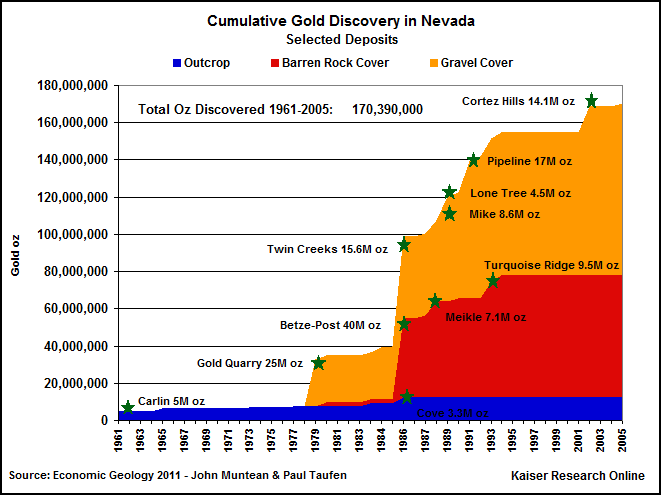
It won't be easy, because Nevada geology is complex and the cover of barren rock or gravel makes target generation difficult, but the prizes waiting for resource exploration juniors to find are substantial and have the potential to deliver triple to quintuple percentage gains. This is no longer a game for prospectors assaying rock chips; it is a game of sophisticated exploration technologies and creative reconstruction of geology in four dimensions. Just imagine what would happen if the new wealth in Silicon Valley developed an interest in Nevada gold exploration as a real world distraction from the applications they are developing for a virtual world that ultimately still rests on the world of materials?